University of Sunderland: APC308 Financial Management Assignment 2019
VerifiedAdded on 2023/01/17
|18
|3883
|59
Homework Assignment
AI Summary
This document presents a comprehensive solution to a financial management assignment, focusing on Kadlex plc. It begins with an introduction to financial management, emphasizing the importance of efficient resource allocation and the role of cost of capital. The first solution calculates the weighted average cost of capital (WACC) using both book and market values, analyzes the impact of a new capital structure, and explores strategies for minimizing the cost of capital through gearing. It also evaluates the effects of short-termism on bankruptcy and agency problems. The second solution addresses equity financing, including calculations for the number of shares to be issued, theoretical ex-right prices, and the expected value of earnings per share, along with a tabular presentation of right issue options and a discussion of scrip dividend advantages. The assignment highlights the critical role of financial planning and decision-making in ensuring a company's long-term success and stability.
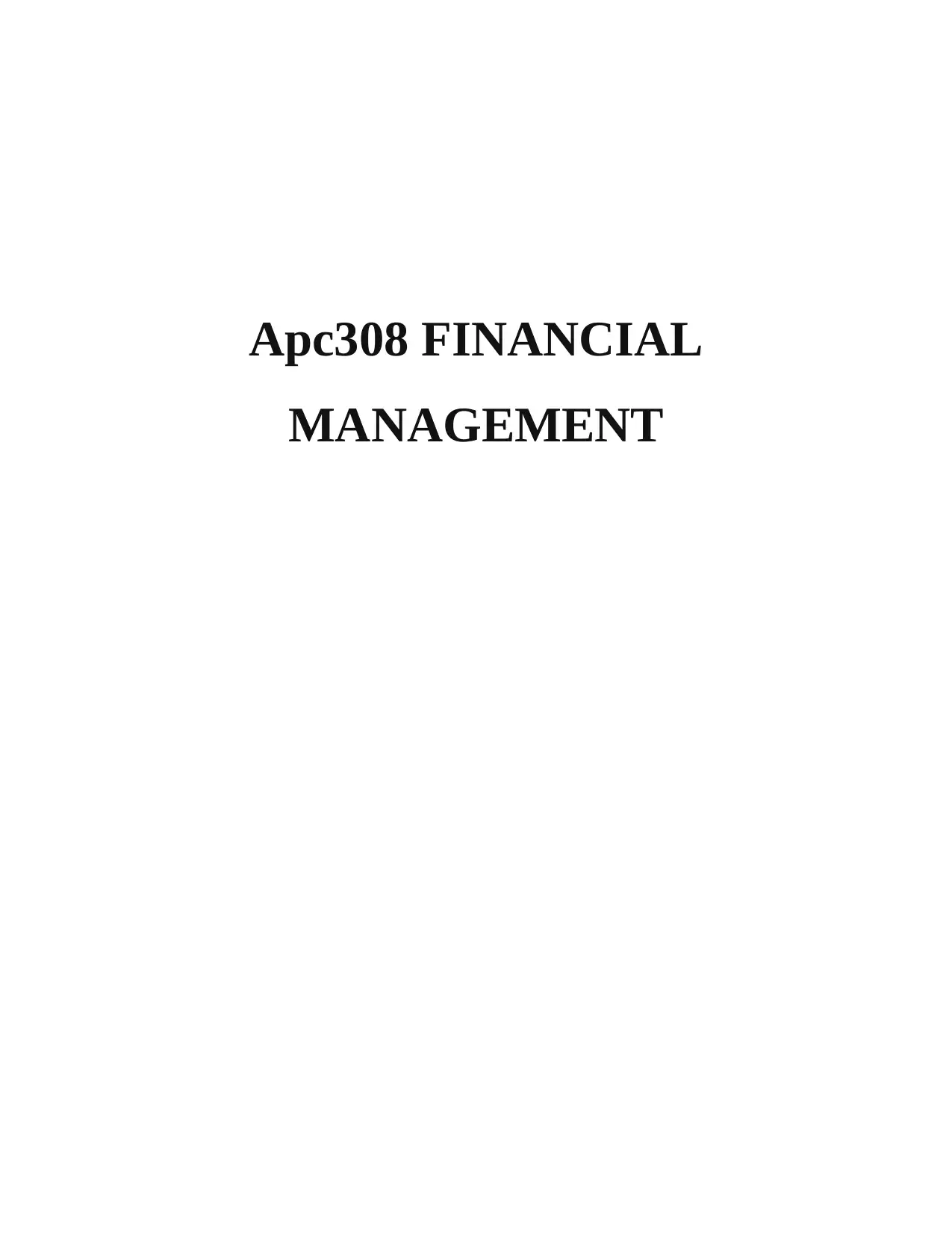
Apc308 FINANCIAL
MANAGEMENT
MANAGEMENT
Paraphrase This Document
Need a fresh take? Get an instant paraphrase of this document with our AI Paraphraser
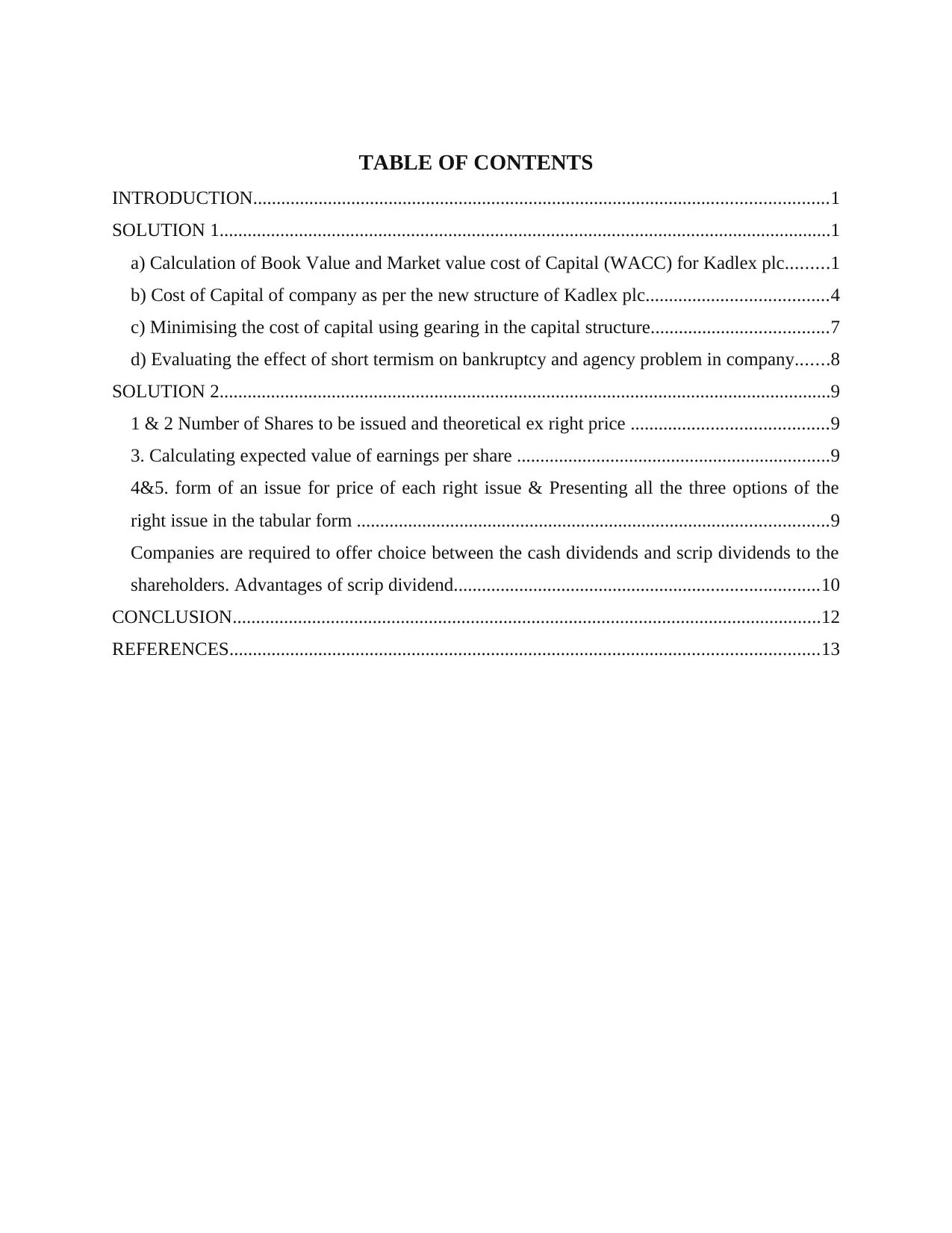
TABLE OF CONTENTS
INTRODUCTION...........................................................................................................................1
SOLUTION 1...................................................................................................................................1
a) Calculation of Book Value and Market value cost of Capital (WACC) for Kadlex plc.........1
b) Cost of Capital of company as per the new structure of Kadlex plc.......................................4
c) Minimising the cost of capital using gearing in the capital structure......................................7
d) Evaluating the effect of short termism on bankruptcy and agency problem in company.......8
SOLUTION 2...................................................................................................................................9
1 & 2 Number of Shares to be issued and theoretical ex right price ..........................................9
3. Calculating expected value of earnings per share ...................................................................9
4&5. form of an issue for price of each right issue & Presenting all the three options of the
right issue in the tabular form .....................................................................................................9
Companies are required to offer choice between the cash dividends and scrip dividends to the
shareholders. Advantages of scrip dividend..............................................................................10
CONCLUSION..............................................................................................................................12
REFERENCES..............................................................................................................................13
INTRODUCTION...........................................................................................................................1
SOLUTION 1...................................................................................................................................1
a) Calculation of Book Value and Market value cost of Capital (WACC) for Kadlex plc.........1
b) Cost of Capital of company as per the new structure of Kadlex plc.......................................4
c) Minimising the cost of capital using gearing in the capital structure......................................7
d) Evaluating the effect of short termism on bankruptcy and agency problem in company.......8
SOLUTION 2...................................................................................................................................9
1 & 2 Number of Shares to be issued and theoretical ex right price ..........................................9
3. Calculating expected value of earnings per share ...................................................................9
4&5. form of an issue for price of each right issue & Presenting all the three options of the
right issue in the tabular form .....................................................................................................9
Companies are required to offer choice between the cash dividends and scrip dividends to the
shareholders. Advantages of scrip dividend..............................................................................10
CONCLUSION..............................................................................................................................12
REFERENCES..............................................................................................................................13
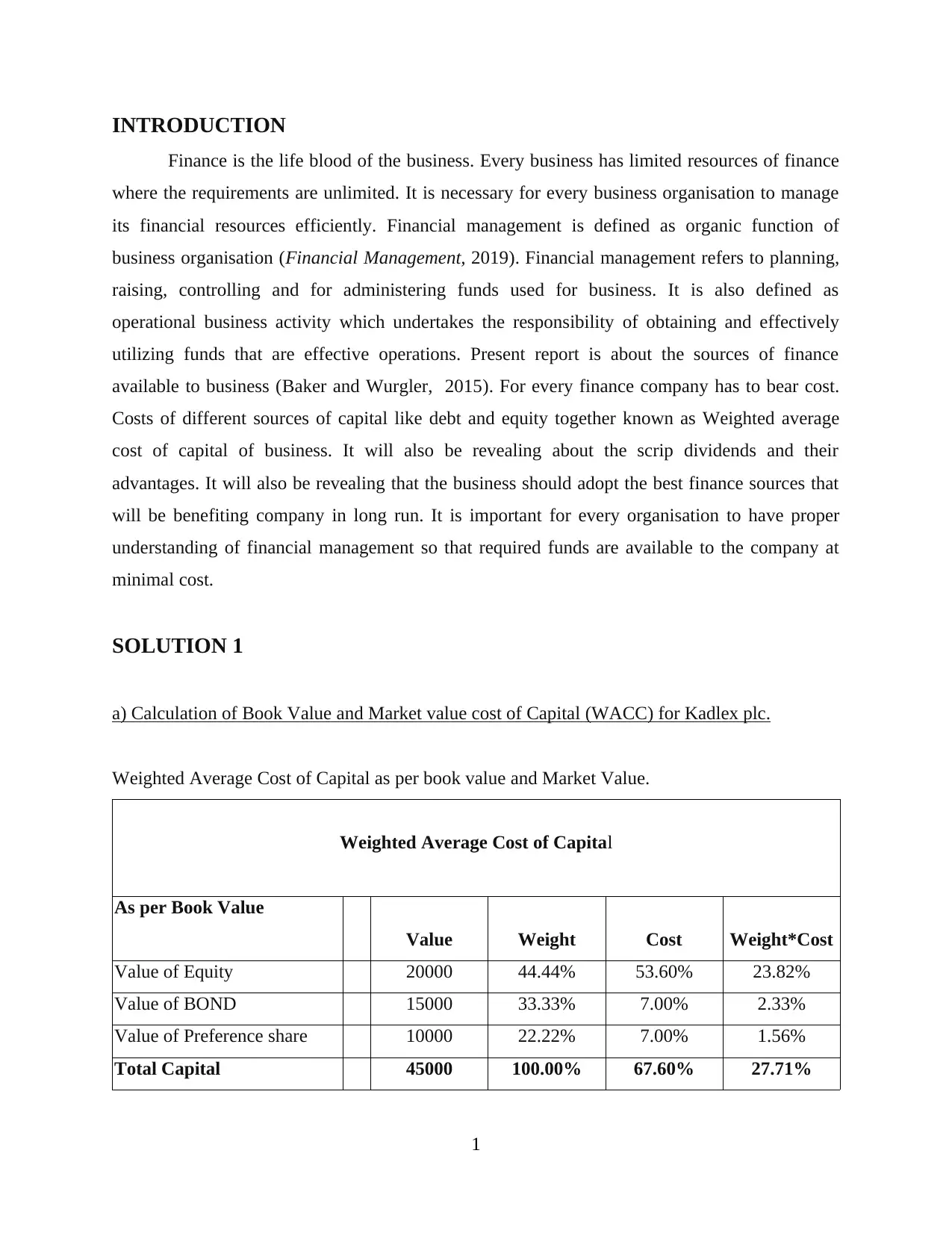
INTRODUCTION
Finance is the life blood of the business. Every business has limited resources of finance
where the requirements are unlimited. It is necessary for every business organisation to manage
its financial resources efficiently. Financial management is defined as organic function of
business organisation (Financial Management, 2019). Financial management refers to planning,
raising, controlling and for administering funds used for business. It is also defined as
operational business activity which undertakes the responsibility of obtaining and effectively
utilizing funds that are effective operations. Present report is about the sources of finance
available to business (Baker and Wurgler, 2015). For every finance company has to bear cost.
Costs of different sources of capital like debt and equity together known as Weighted average
cost of capital of business. It will also be revealing about the scrip dividends and their
advantages. It will also be revealing that the business should adopt the best finance sources that
will be benefiting company in long run. It is important for every organisation to have proper
understanding of financial management so that required funds are available to the company at
minimal cost.
SOLUTION 1
a) Calculation of Book Value and Market value cost of Capital (WACC) for Kadlex plc.
Weighted Average Cost of Capital as per book value and Market Value.
Weighted Average Cost of Capital
As per Book Value
Value Weight Cost Weight*Cost
Value of Equity 20000 44.44% 53.60% 23.82%
Value of BOND 15000 33.33% 7.00% 2.33%
Value of Preference share 10000 22.22% 7.00% 1.56%
Total Capital 45000 100.00% 67.60% 27.71%
1
Finance is the life blood of the business. Every business has limited resources of finance
where the requirements are unlimited. It is necessary for every business organisation to manage
its financial resources efficiently. Financial management is defined as organic function of
business organisation (Financial Management, 2019). Financial management refers to planning,
raising, controlling and for administering funds used for business. It is also defined as
operational business activity which undertakes the responsibility of obtaining and effectively
utilizing funds that are effective operations. Present report is about the sources of finance
available to business (Baker and Wurgler, 2015). For every finance company has to bear cost.
Costs of different sources of capital like debt and equity together known as Weighted average
cost of capital of business. It will also be revealing about the scrip dividends and their
advantages. It will also be revealing that the business should adopt the best finance sources that
will be benefiting company in long run. It is important for every organisation to have proper
understanding of financial management so that required funds are available to the company at
minimal cost.
SOLUTION 1
a) Calculation of Book Value and Market value cost of Capital (WACC) for Kadlex plc.
Weighted Average Cost of Capital as per book value and Market Value.
Weighted Average Cost of Capital
As per Book Value
Value Weight Cost Weight*Cost
Value of Equity 20000 44.44% 53.60% 23.82%
Value of BOND 15000 33.33% 7.00% 2.33%
Value of Preference share 10000 22.22% 7.00% 1.56%
Total Capital 45000 100.00% 67.60% 27.71%
1
⊘ This is a preview!⊘
Do you want full access?
Subscribe today to unlock all pages.

Trusted by 1+ million students worldwide
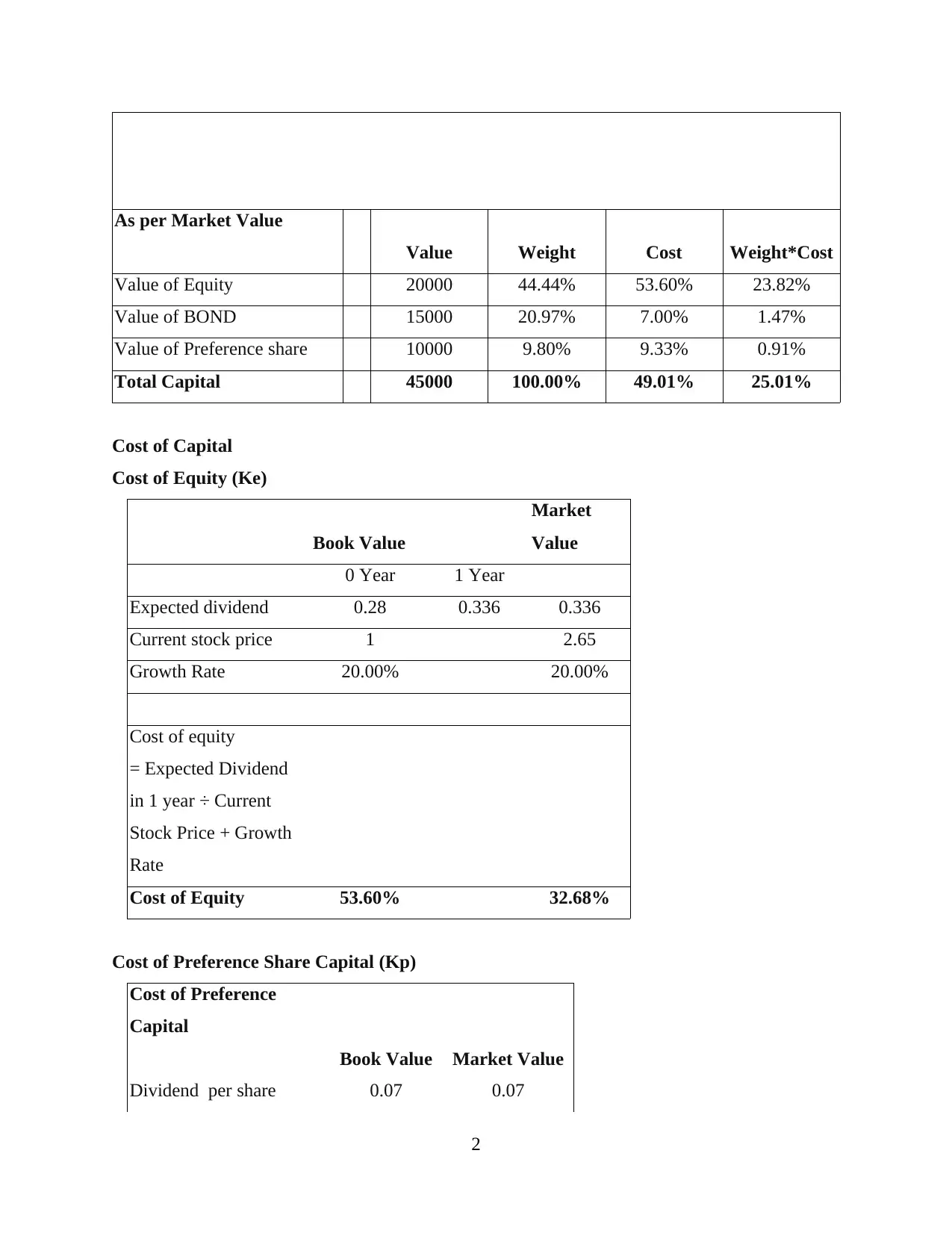
As per Market Value
Value Weight Cost Weight*Cost
Value of Equity 20000 44.44% 53.60% 23.82%
Value of BOND 15000 20.97% 7.00% 1.47%
Value of Preference share 10000 9.80% 9.33% 0.91%
Total Capital 45000 100.00% 49.01% 25.01%
Cost of Capital
Cost of Equity (Ke)
Book Value
Market
Value
0 Year 1 Year
Expected dividend 0.28 0.336 0.336
Current stock price 1 2.65
Growth Rate 20.00% 20.00%
Cost of equity
= Expected Dividend
in 1 year ÷ Current
Stock Price + Growth
Rate
Cost of Equity 53.60% 32.68%
Cost of Preference Share Capital (Kp)
Cost of Preference
Capital
Book Value Market Value
Dividend per share 0.07 0.07
2
Value Weight Cost Weight*Cost
Value of Equity 20000 44.44% 53.60% 23.82%
Value of BOND 15000 20.97% 7.00% 1.47%
Value of Preference share 10000 9.80% 9.33% 0.91%
Total Capital 45000 100.00% 49.01% 25.01%
Cost of Capital
Cost of Equity (Ke)
Book Value
Market
Value
0 Year 1 Year
Expected dividend 0.28 0.336 0.336
Current stock price 1 2.65
Growth Rate 20.00% 20.00%
Cost of equity
= Expected Dividend
in 1 year ÷ Current
Stock Price + Growth
Rate
Cost of Equity 53.60% 32.68%
Cost of Preference Share Capital (Kp)
Cost of Preference
Capital
Book Value Market Value
Dividend per share 0.07 0.07
2
Paraphrase This Document
Need a fresh take? Get an instant paraphrase of this document with our AI Paraphraser
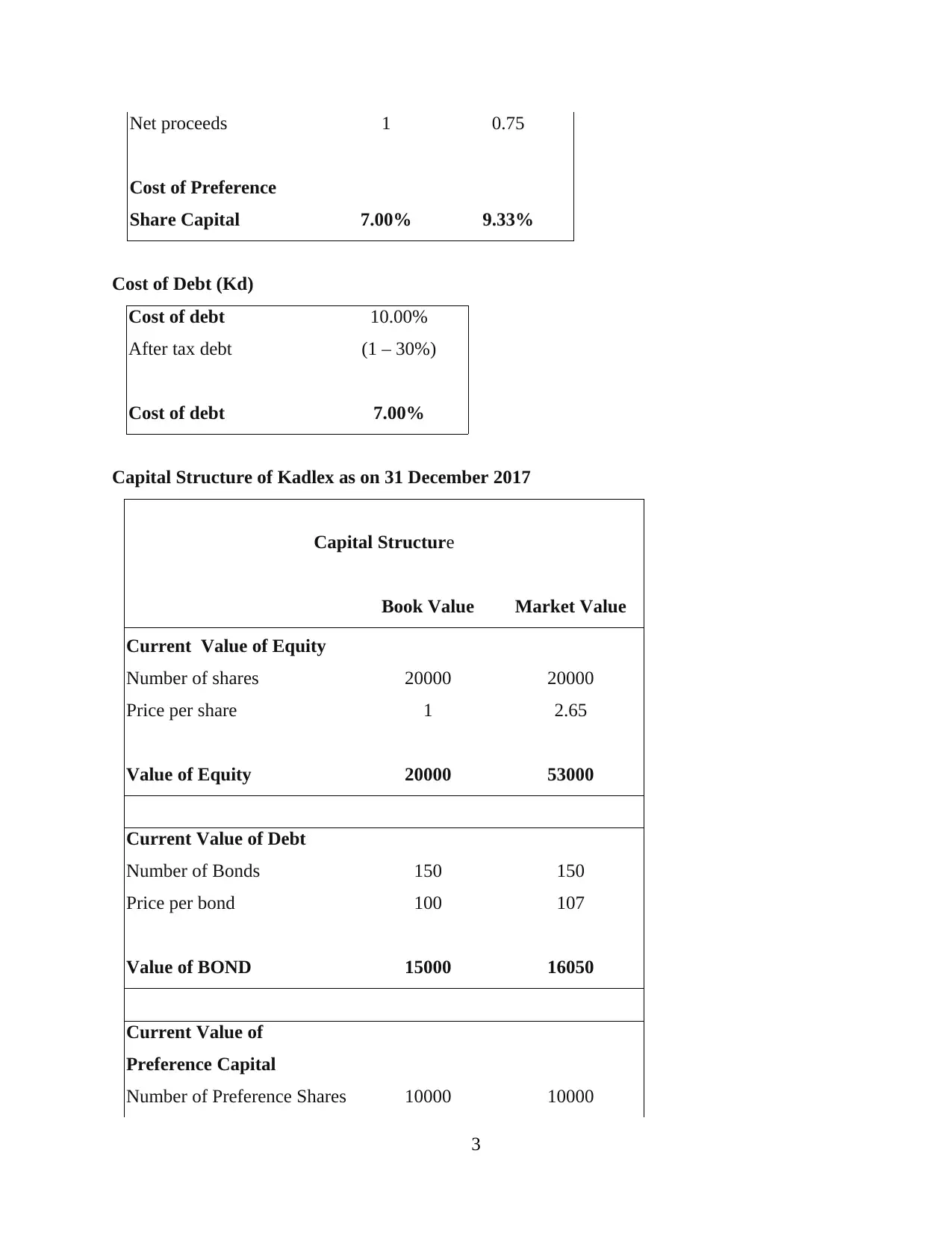
Net proceeds 1 0.75
Cost of Preference
Share Capital 7.00% 9.33%
Cost of Debt (Kd)
Cost of debt 10.00%
After tax debt (1 – 30%)
Cost of debt 7.00%
Capital Structure of Kadlex as on 31 December 2017
Capital Structure
Book Value Market Value
Current Value of Equity
Number of shares 20000 20000
Price per share 1 2.65
Value of Equity 20000 53000
Current Value of Debt
Number of Bonds 150 150
Price per bond 100 107
Value of BOND 15000 16050
Current Value of
Preference Capital
Number of Preference Shares 10000 10000
3
Cost of Preference
Share Capital 7.00% 9.33%
Cost of Debt (Kd)
Cost of debt 10.00%
After tax debt (1 – 30%)
Cost of debt 7.00%
Capital Structure of Kadlex as on 31 December 2017
Capital Structure
Book Value Market Value
Current Value of Equity
Number of shares 20000 20000
Price per share 1 2.65
Value of Equity 20000 53000
Current Value of Debt
Number of Bonds 150 150
Price per bond 100 107
Value of BOND 15000 16050
Current Value of
Preference Capital
Number of Preference Shares 10000 10000
3
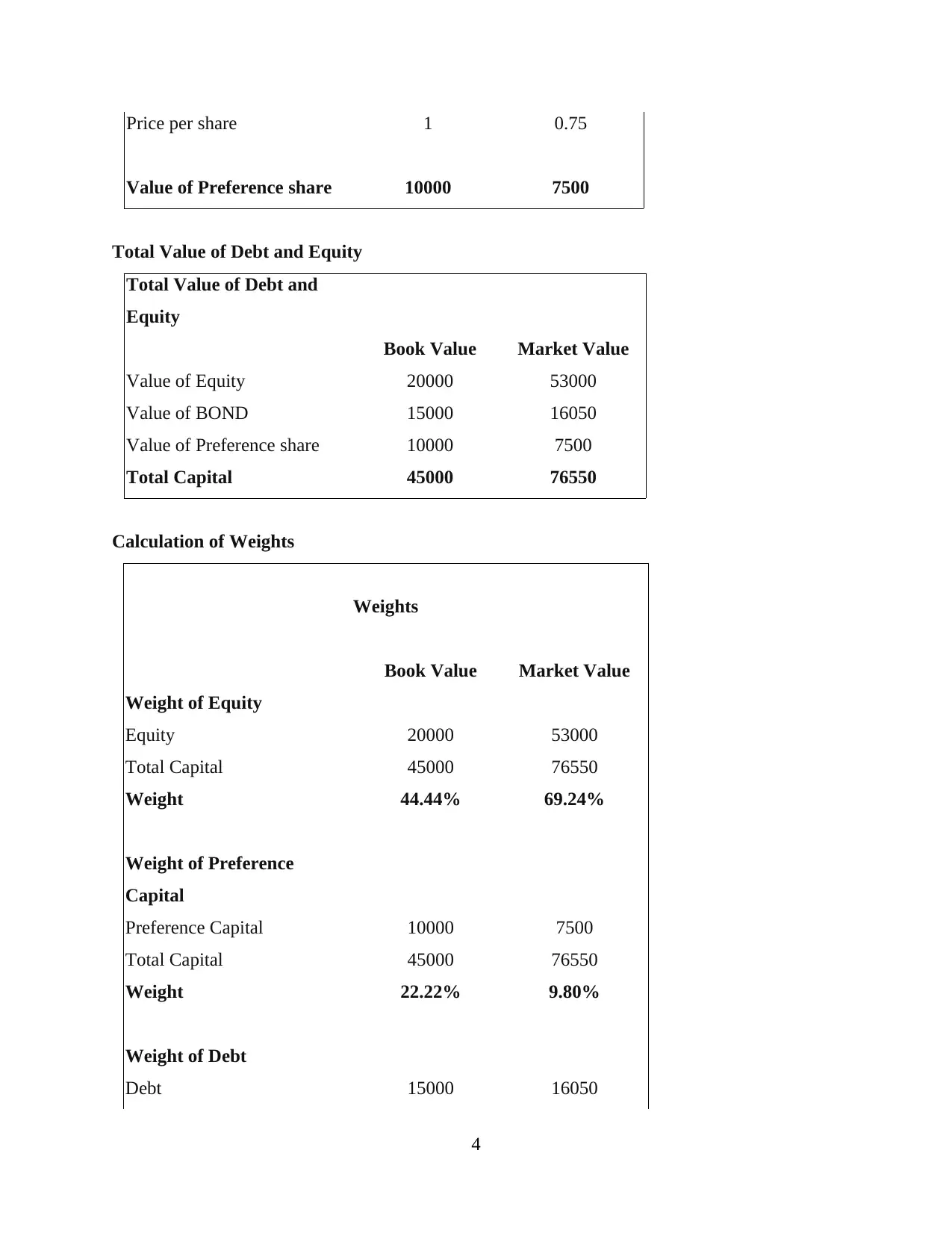
Price per share 1 0.75
Value of Preference share 10000 7500
Total Value of Debt and Equity
Total Value of Debt and
Equity
Book Value Market Value
Value of Equity 20000 53000
Value of BOND 15000 16050
Value of Preference share 10000 7500
Total Capital 45000 76550
Calculation of Weights
Weights
Book Value Market Value
Weight of Equity
Equity 20000 53000
Total Capital 45000 76550
Weight 44.44% 69.24%
Weight of Preference
Capital
Preference Capital 10000 7500
Total Capital 45000 76550
Weight 22.22% 9.80%
Weight of Debt
Debt 15000 16050
4
Value of Preference share 10000 7500
Total Value of Debt and Equity
Total Value of Debt and
Equity
Book Value Market Value
Value of Equity 20000 53000
Value of BOND 15000 16050
Value of Preference share 10000 7500
Total Capital 45000 76550
Calculation of Weights
Weights
Book Value Market Value
Weight of Equity
Equity 20000 53000
Total Capital 45000 76550
Weight 44.44% 69.24%
Weight of Preference
Capital
Preference Capital 10000 7500
Total Capital 45000 76550
Weight 22.22% 9.80%
Weight of Debt
Debt 15000 16050
4
⊘ This is a preview!⊘
Do you want full access?
Subscribe today to unlock all pages.

Trusted by 1+ million students worldwide
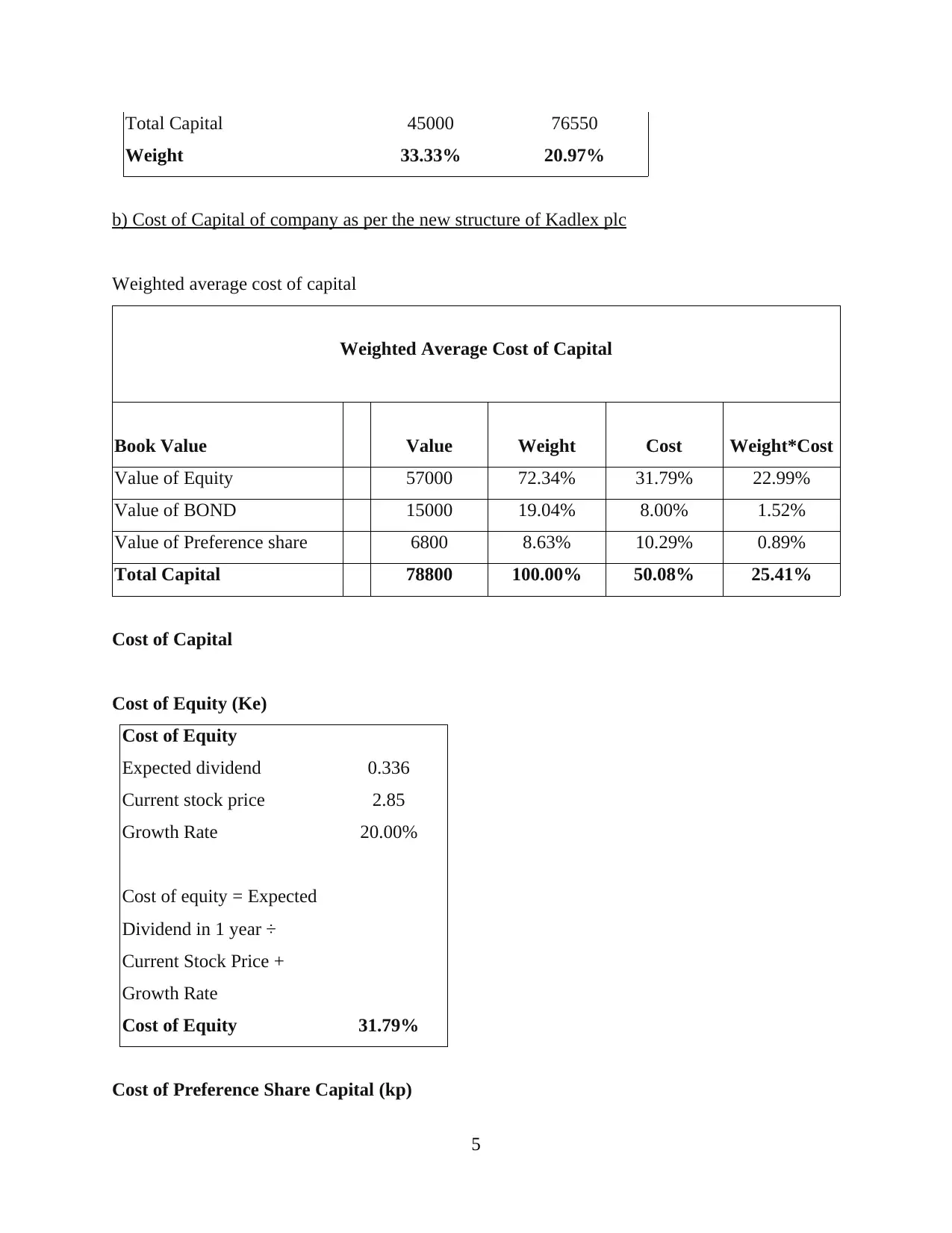
Total Capital 45000 76550
Weight 33.33% 20.97%
b) Cost of Capital of company as per the new structure of Kadlex plc
Weighted average cost of capital
Weighted Average Cost of Capital
Book Value Value Weight Cost Weight*Cost
Value of Equity 57000 72.34% 31.79% 22.99%
Value of BOND 15000 19.04% 8.00% 1.52%
Value of Preference share 6800 8.63% 10.29% 0.89%
Total Capital 78800 100.00% 50.08% 25.41%
Cost of Capital
Cost of Equity (Ke)
Cost of Equity
Expected dividend 0.336
Current stock price 2.85
Growth Rate 20.00%
Cost of equity = Expected
Dividend in 1 year ÷
Current Stock Price +
Growth Rate
Cost of Equity 31.79%
Cost of Preference Share Capital (kp)
5
Weight 33.33% 20.97%
b) Cost of Capital of company as per the new structure of Kadlex plc
Weighted average cost of capital
Weighted Average Cost of Capital
Book Value Value Weight Cost Weight*Cost
Value of Equity 57000 72.34% 31.79% 22.99%
Value of BOND 15000 19.04% 8.00% 1.52%
Value of Preference share 6800 8.63% 10.29% 0.89%
Total Capital 78800 100.00% 50.08% 25.41%
Cost of Capital
Cost of Equity (Ke)
Cost of Equity
Expected dividend 0.336
Current stock price 2.85
Growth Rate 20.00%
Cost of equity = Expected
Dividend in 1 year ÷
Current Stock Price +
Growth Rate
Cost of Equity 31.79%
Cost of Preference Share Capital (kp)
5
Paraphrase This Document
Need a fresh take? Get an instant paraphrase of this document with our AI Paraphraser
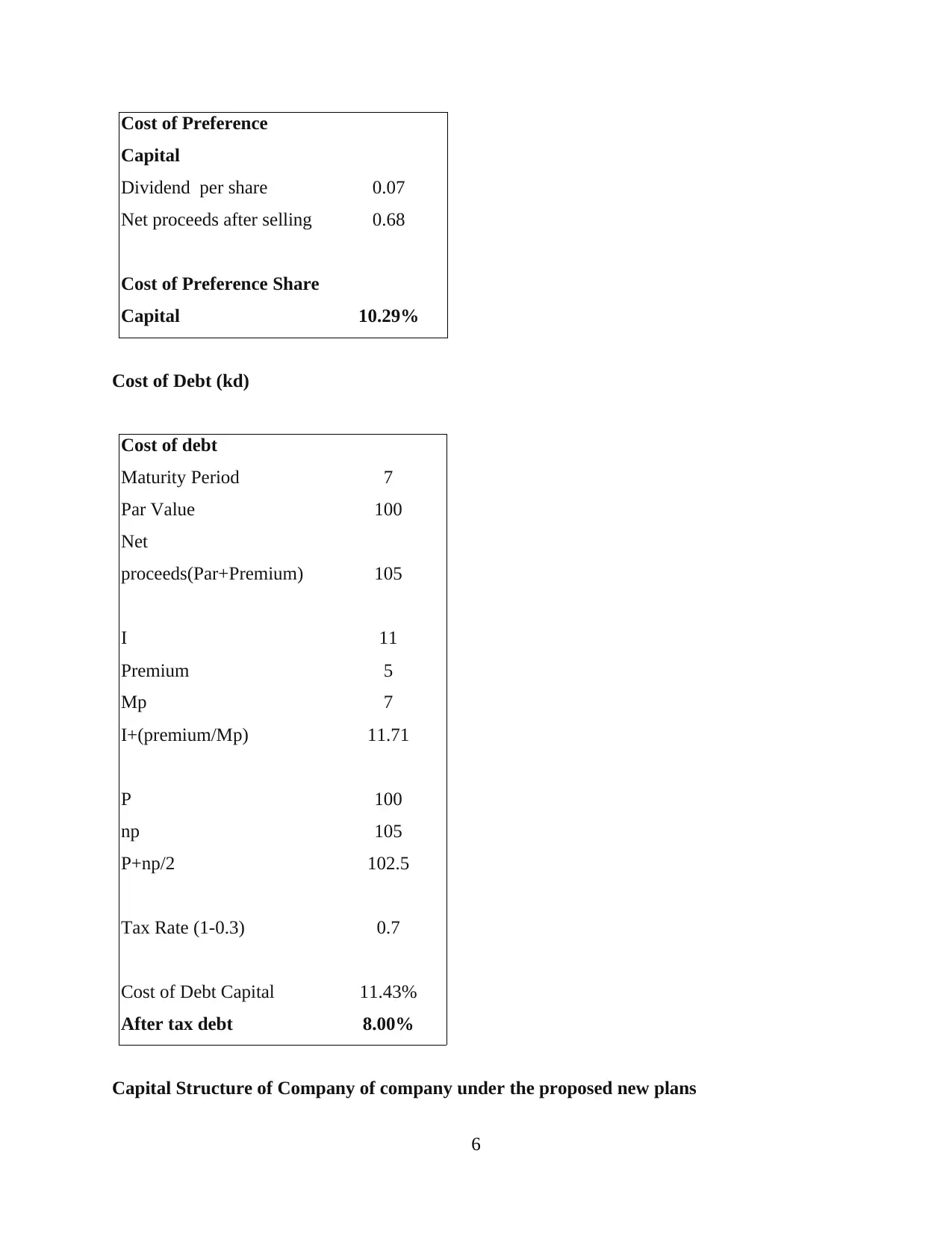
Cost of Preference
Capital
Dividend per share 0.07
Net proceeds after selling 0.68
Cost of Preference Share
Capital 10.29%
Cost of Debt (kd)
Cost of debt
Maturity Period 7
Par Value 100
Net
proceeds(Par+Premium) 105
I 11
Premium 5
Mp 7
I+(premium/Mp) 11.71
P 100
np 105
P+np/2 102.5
Tax Rate (1-0.3) 0.7
Cost of Debt Capital 11.43%
After tax debt 8.00%
Capital Structure of Company of company under the proposed new plans
6
Capital
Dividend per share 0.07
Net proceeds after selling 0.68
Cost of Preference Share
Capital 10.29%
Cost of Debt (kd)
Cost of debt
Maturity Period 7
Par Value 100
Net
proceeds(Par+Premium) 105
I 11
Premium 5
Mp 7
I+(premium/Mp) 11.71
P 100
np 105
P+np/2 102.5
Tax Rate (1-0.3) 0.7
Cost of Debt Capital 11.43%
After tax debt 8.00%
Capital Structure of Company of company under the proposed new plans
6

Value of Equity
7
7
⊘ This is a preview!⊘
Do you want full access?
Subscribe today to unlock all pages.

Trusted by 1+ million students worldwide
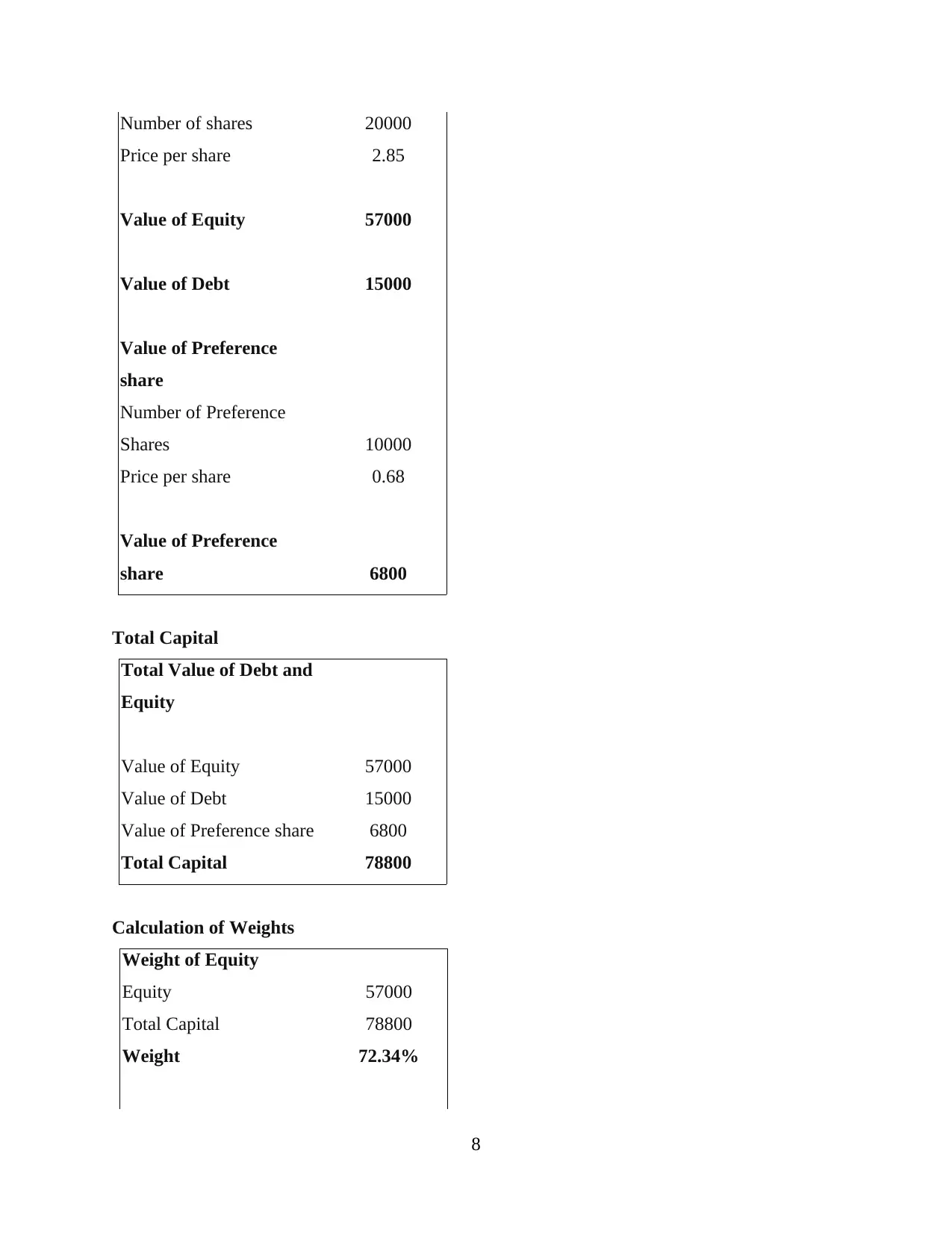
Number of shares 20000
Price per share 2.85
Value of Equity 57000
Value of Debt 15000
Value of Preference
share
Number of Preference
Shares 10000
Price per share 0.68
Value of Preference
share 6800
Total Capital
Total Value of Debt and
Equity
Value of Equity 57000
Value of Debt 15000
Value of Preference share 6800
Total Capital 78800
Calculation of Weights
Weight of Equity
Equity 57000
Total Capital 78800
Weight 72.34%
8
Price per share 2.85
Value of Equity 57000
Value of Debt 15000
Value of Preference
share
Number of Preference
Shares 10000
Price per share 0.68
Value of Preference
share 6800
Total Capital
Total Value of Debt and
Equity
Value of Equity 57000
Value of Debt 15000
Value of Preference share 6800
Total Capital 78800
Calculation of Weights
Weight of Equity
Equity 57000
Total Capital 78800
Weight 72.34%
8
Paraphrase This Document
Need a fresh take? Get an instant paraphrase of this document with our AI Paraphraser
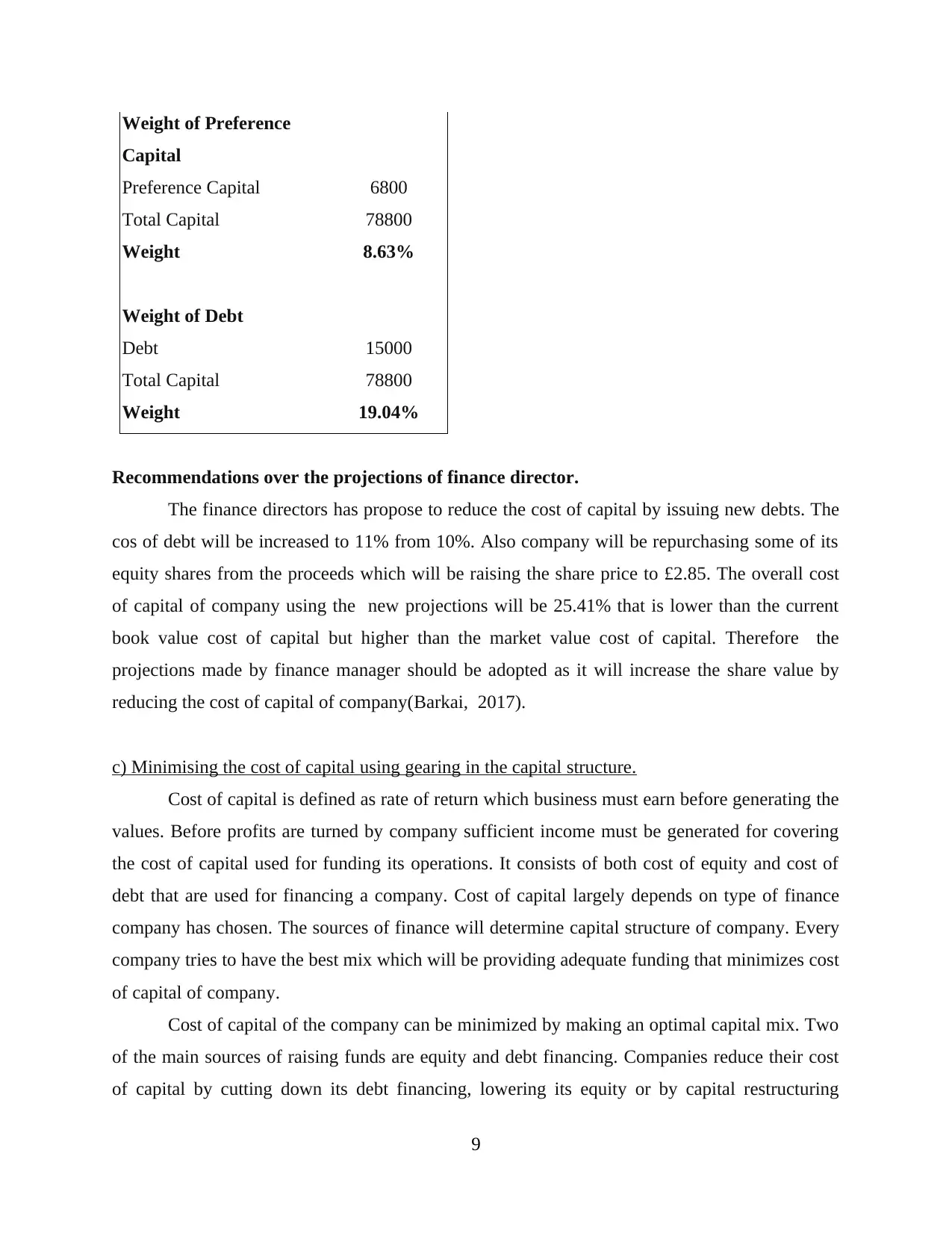
Weight of Preference
Capital
Preference Capital 6800
Total Capital 78800
Weight 8.63%
Weight of Debt
Debt 15000
Total Capital 78800
Weight 19.04%
Recommendations over the projections of finance director.
The finance directors has propose to reduce the cost of capital by issuing new debts. The
cos of debt will be increased to 11% from 10%. Also company will be repurchasing some of its
equity shares from the proceeds which will be raising the share price to £2.85. The overall cost
of capital of company using the new projections will be 25.41% that is lower than the current
book value cost of capital but higher than the market value cost of capital. Therefore the
projections made by finance manager should be adopted as it will increase the share value by
reducing the cost of capital of company(Barkai, 2017).
c) Minimising the cost of capital using gearing in the capital structure.
Cost of capital is defined as rate of return which business must earn before generating the
values. Before profits are turned by company sufficient income must be generated for covering
the cost of capital used for funding its operations. It consists of both cost of equity and cost of
debt that are used for financing a company. Cost of capital largely depends on type of finance
company has chosen. The sources of finance will determine capital structure of company. Every
company tries to have the best mix which will be providing adequate funding that minimizes cost
of capital of company.
Cost of capital of the company can be minimized by making an optimal capital mix. Two
of the main sources of raising funds are equity and debt financing. Companies reduce their cost
of capital by cutting down its debt financing, lowering its equity or by capital restructuring
9
Capital
Preference Capital 6800
Total Capital 78800
Weight 8.63%
Weight of Debt
Debt 15000
Total Capital 78800
Weight 19.04%
Recommendations over the projections of finance director.
The finance directors has propose to reduce the cost of capital by issuing new debts. The
cos of debt will be increased to 11% from 10%. Also company will be repurchasing some of its
equity shares from the proceeds which will be raising the share price to £2.85. The overall cost
of capital of company using the new projections will be 25.41% that is lower than the current
book value cost of capital but higher than the market value cost of capital. Therefore the
projections made by finance manager should be adopted as it will increase the share value by
reducing the cost of capital of company(Barkai, 2017).
c) Minimising the cost of capital using gearing in the capital structure.
Cost of capital is defined as rate of return which business must earn before generating the
values. Before profits are turned by company sufficient income must be generated for covering
the cost of capital used for funding its operations. It consists of both cost of equity and cost of
debt that are used for financing a company. Cost of capital largely depends on type of finance
company has chosen. The sources of finance will determine capital structure of company. Every
company tries to have the best mix which will be providing adequate funding that minimizes cost
of capital of company.
Cost of capital of the company can be minimized by making an optimal capital mix. Two
of the main sources of raising funds are equity and debt financing. Companies reduce their cost
of capital by cutting down its debt financing, lowering its equity or by capital restructuring
9
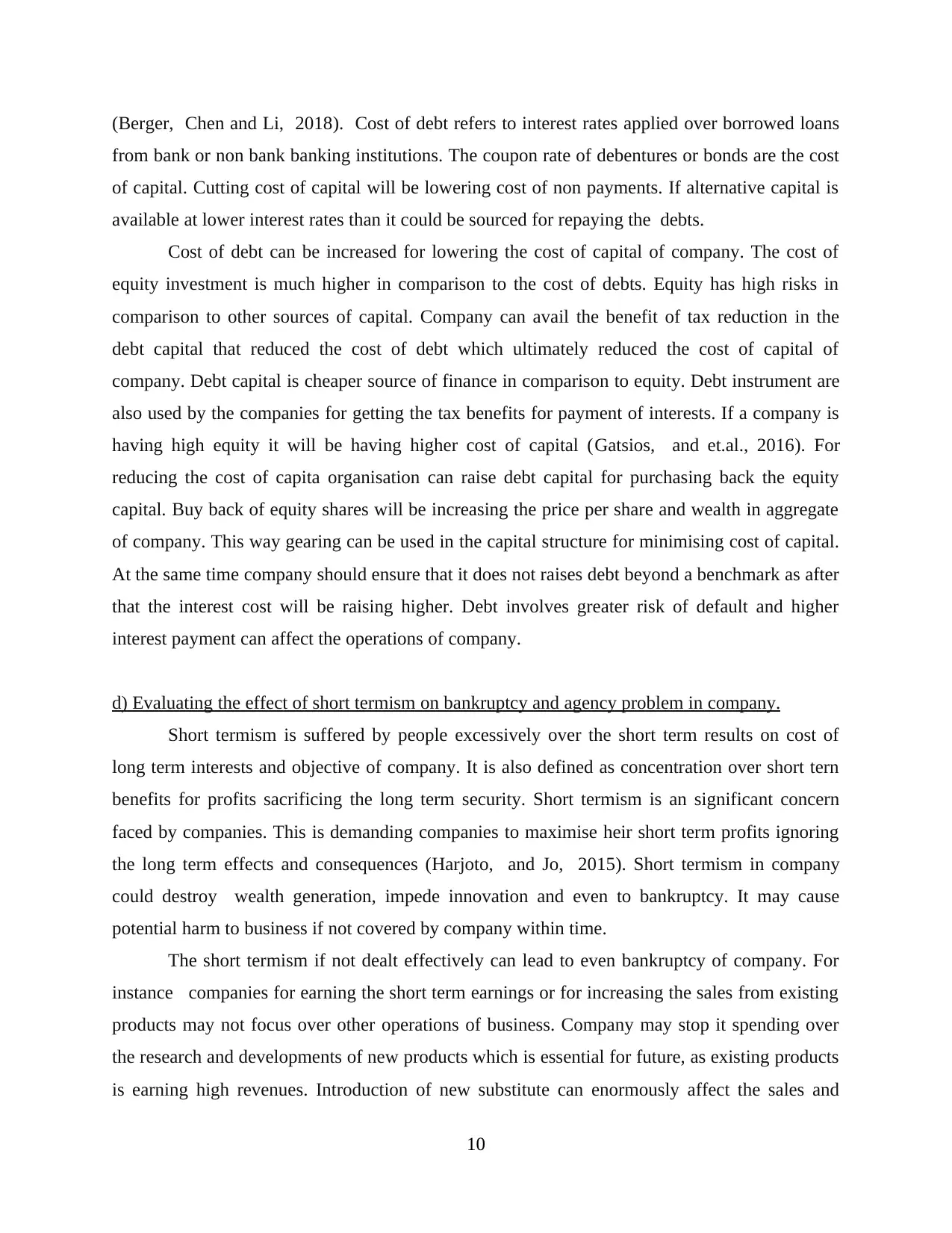
(Berger, Chen and Li, 2018). Cost of debt refers to interest rates applied over borrowed loans
from bank or non bank banking institutions. The coupon rate of debentures or bonds are the cost
of capital. Cutting cost of capital will be lowering cost of non payments. If alternative capital is
available at lower interest rates than it could be sourced for repaying the debts.
Cost of debt can be increased for lowering the cost of capital of company. The cost of
equity investment is much higher in comparison to the cost of debts. Equity has high risks in
comparison to other sources of capital. Company can avail the benefit of tax reduction in the
debt capital that reduced the cost of debt which ultimately reduced the cost of capital of
company. Debt capital is cheaper source of finance in comparison to equity. Debt instrument are
also used by the companies for getting the tax benefits for payment of interests. If a company is
having high equity it will be having higher cost of capital (Gatsios, and et.al., 2016). For
reducing the cost of capita organisation can raise debt capital for purchasing back the equity
capital. Buy back of equity shares will be increasing the price per share and wealth in aggregate
of company. This way gearing can be used in the capital structure for minimising cost of capital.
At the same time company should ensure that it does not raises debt beyond a benchmark as after
that the interest cost will be raising higher. Debt involves greater risk of default and higher
interest payment can affect the operations of company.
d) Evaluating the effect of short termism on bankruptcy and agency problem in company.
Short termism is suffered by people excessively over the short term results on cost of
long term interests and objective of company. It is also defined as concentration over short tern
benefits for profits sacrificing the long term security. Short termism is an significant concern
faced by companies. This is demanding companies to maximise heir short term profits ignoring
the long term effects and consequences (Harjoto, and Jo, 2015). Short termism in company
could destroy wealth generation, impede innovation and even to bankruptcy. It may cause
potential harm to business if not covered by company within time.
The short termism if not dealt effectively can lead to even bankruptcy of company. For
instance companies for earning the short term earnings or for increasing the sales from existing
products may not focus over other operations of business. Company may stop it spending over
the research and developments of new products which is essential for future, as existing products
is earning high revenues. Introduction of new substitute can enormously affect the sales and
10
from bank or non bank banking institutions. The coupon rate of debentures or bonds are the cost
of capital. Cutting cost of capital will be lowering cost of non payments. If alternative capital is
available at lower interest rates than it could be sourced for repaying the debts.
Cost of debt can be increased for lowering the cost of capital of company. The cost of
equity investment is much higher in comparison to the cost of debts. Equity has high risks in
comparison to other sources of capital. Company can avail the benefit of tax reduction in the
debt capital that reduced the cost of debt which ultimately reduced the cost of capital of
company. Debt capital is cheaper source of finance in comparison to equity. Debt instrument are
also used by the companies for getting the tax benefits for payment of interests. If a company is
having high equity it will be having higher cost of capital (Gatsios, and et.al., 2016). For
reducing the cost of capita organisation can raise debt capital for purchasing back the equity
capital. Buy back of equity shares will be increasing the price per share and wealth in aggregate
of company. This way gearing can be used in the capital structure for minimising cost of capital.
At the same time company should ensure that it does not raises debt beyond a benchmark as after
that the interest cost will be raising higher. Debt involves greater risk of default and higher
interest payment can affect the operations of company.
d) Evaluating the effect of short termism on bankruptcy and agency problem in company.
Short termism is suffered by people excessively over the short term results on cost of
long term interests and objective of company. It is also defined as concentration over short tern
benefits for profits sacrificing the long term security. Short termism is an significant concern
faced by companies. This is demanding companies to maximise heir short term profits ignoring
the long term effects and consequences (Harjoto, and Jo, 2015). Short termism in company
could destroy wealth generation, impede innovation and even to bankruptcy. It may cause
potential harm to business if not covered by company within time.
The short termism if not dealt effectively can lead to even bankruptcy of company. For
instance companies for earning the short term earnings or for increasing the sales from existing
products may not focus over other operations of business. Company may stop it spending over
the research and developments of new products which is essential for future, as existing products
is earning high revenues. Introduction of new substitute can enormously affect the sales and
10
⊘ This is a preview!⊘
Do you want full access?
Subscribe today to unlock all pages.

Trusted by 1+ million students worldwide
1 out of 18
Related Documents
Your All-in-One AI-Powered Toolkit for Academic Success.
+13062052269
info@desklib.com
Available 24*7 on WhatsApp / Email
![[object Object]](/_next/static/media/star-bottom.7253800d.svg)
Unlock your academic potential
Copyright © 2020–2026 A2Z Services. All Rights Reserved. Developed and managed by ZUCOL.





